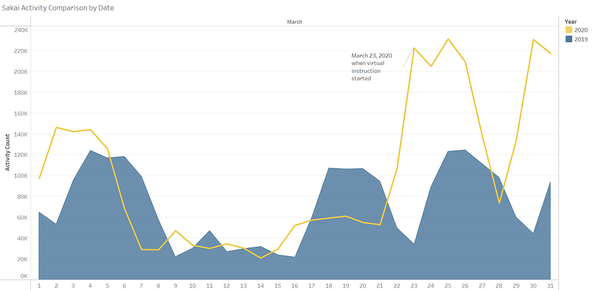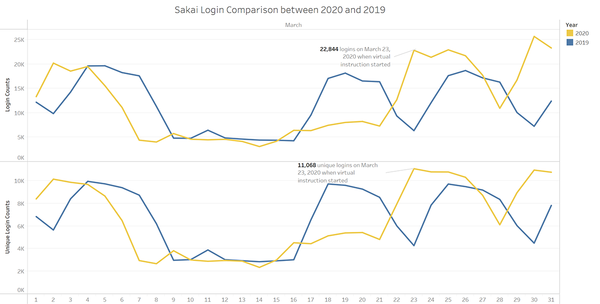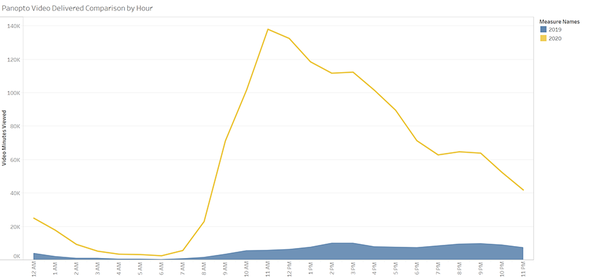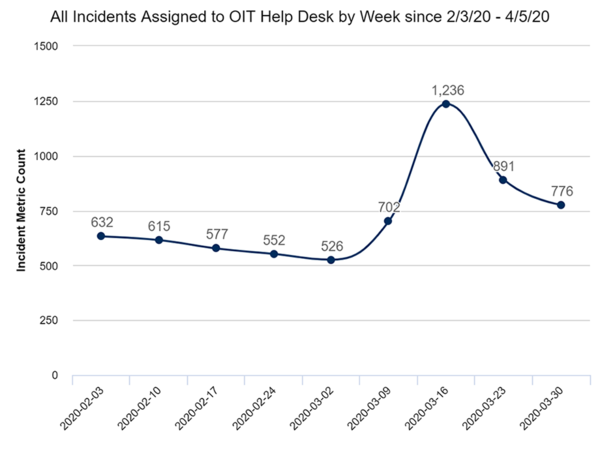
The Office of Information Technologies (OIT) serves as Notre Dame’s trusted technology partner. While the demands of technology continue to expand, the OIT works hard to keep up with reviewing new services, as well as maintaining existing services including those to help faculty, staff and students work remotely.
In mid-March, the University began to announce efforts to reduce the likelihood of transmission of the coronavirus to the Notre Dame community.
For faculty and students, all in-person classes and nearly all laboratory research operations were suspended. As a result, faculty and students needed to quickly familiarize themselves with IT tools and make sure they worked to be able to conduct or attend their classes remotely.
Most staff members were asked to work remotely if their roles allowed for it—and to use IT tools and services they may not have used before to allow them to work away from campus.
The need to ensure the necessary IT services were available to faculty, staff and students in a short amount of time was paramount. Plus, other aspects of these services such as security, availability of features, capacity, etc., needed to be examined as well to make certain they could be used successfully off campus.
So the Office of Information Technologies (OIT) focused its teams and resources to meet this unprecedented challenge head-on.
“While remote learning, teaching, and work has never been our primary mode of operation, our IT teams set up Notre Dame with a strong foundation of critical IT services that allowed the University to quickly shift to reliable online operations,” said Katie Rose, senior director for IT strategy, planning & architecture.
Access to Services Supporting Remote Work
There were several services that needed to be reviewed and assessed in order to prepare the campus to work remotely. The primary services include:
- Zoom conferencing service: This service is available to faculty, staff and students to host and/or participate in online audio and video conferences.
- Sakai learning management system: This online platform has a robust set of tools allowing instructors to deliver digital course content, collect assignments and post student grades.
- Panopto lecture capture system: This specialized tool makes it possible to upload, store and deliver course related video content. Faculty can upload recordings of online classes that meet via Zoom for students who miss a class or want to watch the class again to better understand critical course content.
With only two weeks until the start of remote instruction, OIT staff and academic support teams worked to increase capacity and tune applications needed to work, teach and learn remotely. The team consisted of more than 100 technologists, project managers, and administrators—nearly half of the OIT’s total employees.
They worked diligently to ensure these services were ready to support both online classes for faculty and students, as well as the meeting and collaboration needs of ND staff. Additionally, the team needed to renegotiate licensing agreements for both Sakai and Panopto to guarantee access due to increased usage.
Below is a summary of how the usage of these services skyrocketed:
Zoom Statistics
| Date Comparisons | Feb. 16-29, 2020 | Mar. 23 - April 6, 2020 |
| # of people actively using Zoom | 1,131 | 10,589 |
| # of Meetings Hosted | 3,535 | 61,776 |
| # of Meeting Participants | 15,601 | 362,560 |
Since faculty, staff and students started working remotely, Zoom usage at Notre Dame averages about 50,000 participants per day.
Sakai Statistics
This graph below shows the overall activity in Sakai activities doubled between March 2019 and March 2020. Activities are course tasks for students, such as turn in assignments, watch videos, take quizzes/tests and participate in online discussions.

When 100% of online classes began on March 23, 2020, the number of Sakai logins doubled compared to March 23, 2019. The total number of unique logins has not increased significantly, but the login frequency has increased when compared before spring break.

Panopto Statistics
After all ND courses were moved online, Panopto use increased by a factor of 25 to 30 times its normal use. Beginning March 23, 2020, students watched more than 3,000 hours of instructional video in Panopto per day compared to 200-250 hours a day before spring break.
The graph below illustrates March 2020 viewing patterns of students watching instructional videos throughout the day compared to March 2019. Most students watch videos in Panopto during their normal class day (Monday through Friday), even though they are watching from their homes or apartments.

Media Production
The OIT ND Studios & Teaching and Learning Technologies staff continues to assist campus users in staying connected and informed with our university mission. In addition to providing studio spaces equipped with synchronous and asynchronous teaching and learning technologies, the team is also providing live streaming delivery of Mass from the Basilica of the Sacred Heart. Furthermore, the OIT ND Studios team is providing media services in the form of video town halls, large team meeting webinars, and informational interviews live streamed to the Notre Dame community.
Live Streaming of Mass from the Basilica of the Sacred Heart
ND Studios continues to assist our Notre Dame community to stay connected with their faith by live streaming Mass from the Basilica of the Sacred Heart. In conjunction with Campus Ministry, ND Studios delivers Mass via live and on-demand streaming to approximately 2,000 to 3,000 viewers each weekday, Monday through Saturday at 11:30 a.m. (ET).
Live streaming of weekday Mass: 36,734 plays (# of times the play button was clicked), and 8,262 unique viewers. This data represents totals as of March 17, 2020.
In addition, Sunday Mass is produced in ND Studios, then distributed via CatholicTV, on both cable TV and live stream, each Sunday at 10 a.m. (ET). They have also seen a substantial increase in viewership.
New Service Allowing Remote Access to Computer Applications
The Virtual Computer Lab service was a project just getting started in the OIT and was scheduled to take about six to nine months to implement—from start to finish. When it was announced that the students would not return from spring break, this project became a top priority, and OIT teams needed to implement this service within a few weeks.
Notre Dame computer labs provide students with access to a variety of computer applications that they do not have installed on their personal computer. Since students were not able to access the labs on campus, they can now use their own computer to access these applications virtually. The Virtual Computer Lab service offers more than 134 different applications, with 7 different computer lab images to handle unique disciplines and needs.
Virtual Computer Lab Implementation Statistics
At its peak, over 20 OIT staff members partnered with the Mendoza College of Business IT team and Engineering & Science Computing team to work on its implementation.
A core team of 12 OIT staff members logged 1,000 hours in three weeks in order to make the Virtual Computer Labs ready to use.
A faculty member stated: “I can't thank you enough for all the hard work you put into getting our students vital access to this software. The timeframe was an incredible challenge, and we were ready to go on the first day of class.”
OIT Support
The current staffing at the OIT Help Desk was not going to be adequate to handle the anticipated number of contacts from faculty, staff and students about the IT services they were going to need to use. Fifteen OIT employees from other areas were temporarily reassigned to the Help Desk to assist with high call volumes and extended hours.
In the past month, Help Desk staff and other IT service owners created or enhanced 162 knowledge articles to ensure accurate instructional material and resources were available to faculty, staff and students. These articles covered a variety of topics including Zoom, Panopto, Sakai, VPN and Virtual Computer Labs.
A convenient reference page was also developed called Technology Resources for COVID-19 Response Activities to help people easily find answers to their questions about working and teaching remotely.
OIT Help Desk Statistics
The graph below shows how the number of contacts to the OIT Help Desk increased once remote work at Notre Dame was required. At the peak, they virtually doubled, and even now, the volume continues to remain higher than normal.

In addition to login issues in Okta, most people contacting the OIT Help Desk have questions about Zoom, VPN (Virtual Private Network), VoIP phone (forwarding work phone to home phone, etc.) and Sakai.
Customer surveys are sent to those who have contacted the OIT Help Desk for assistance, and they can comment on their experience:
“Very impressed you would never know we are all working remotely. OIT is always very helpful, and we would be lost without them. Thank you for supporting all of us as we try and learn a few new tricks when doing our usual routine away from the office.”
“Thank you for all you are doing while everyone tries to navigate working from home. I appreciate it! Stay safe and healthy.”
“Even though I had to work with several different analysts, I appreciated their determination to resolve my issue and the patience they used (especially during a time of being so overwhelmed). The OIT staff is like no other!”
The entire OIT department came together in a short period of time to provide a whole new level of support and continues to ensure these services are reliable, secure and robust.
Katie Rose concluded, “I am so proud of the dedication and efforts of our IT professionals in the OIT and throughout Notre Dame to ensure that online classes for faculty and students, and remote work for employees began as smoothly as possible.”